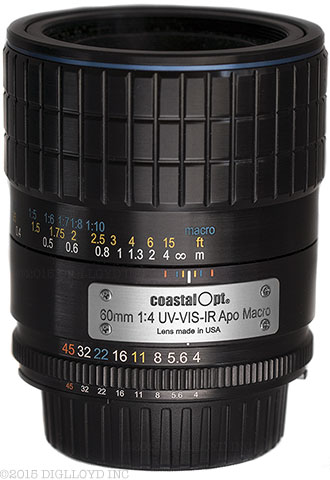
|

$220 SAVE $130 = 37.0% Western Digital 16.0TB Western Digital Ultrastar DC HC550 3.5-in… in Storage: Hard Drives
|

|

|

|

|
Hot Spot Issue
Related: apochromatic, Coastal Optics, Coastal Optics 60mm f/4 UV-VIS-IR APO-Macro, macro, optics
Full review of the Coastal Optics 60mm f/4 UV-VIS-IR APO MACRO is found in DAP.
There is an ongoing controversy concerning a hot spot issue, especially at high magnifications and small apertures (eg f/22 - f/45).
I have never observed the problem, perhaps because I rarely shoot macro in the 1:3 and closer range, and I rarely stop down beyond f/8, where the problem is provoked. My assessment is that you’ll have to look hard for a problem to find one. And at f/11 on down, diffraction kills an optical wonderfulness (?!) the Coastal has anyway, unless it’s IR or UV you’re after.
The optical designer of the Coastal 60/4, James Brian Caldwell (US Patent #20090296201), confirms that there is a hot spot problem at small apertures at magnifications 1:3 and larger, but that at longer distances no problem exists:
The hotspot issue still exists for closeup shots (1:3 and closer) taken at small apertures. A workaround for macro photography is to focus the lens no closer than 1:3 and then use extension rings to achieve the desired closeup magnification. For very high magnifications the lens should work very well reversed on a bellows with the focus ring set to the reciprocal of the magnification, but I have not thoroughly tested this for hotspots. As far as I know the lens is completely immune to hotspotting for magnifications less than 1:3 regardless of the aperture or filter used.
Elaborating, he states:
Hotspotting is an optical issue. It has nothing to do with internal mechanical parts. Specifically, a central hotspot is a ghost image of the aperture stop created by two ghost reflections. These reflections can occur between any two lens surfaces, or it can be a reflection off the sensor or coverglass followed by a reflection from a lens surface.
In the case of the Coastal 60mm lens there is never a sharply focused ghost image of the stop, even at closest focus. However when you focus to 1:3 a very weak and defocused hotspot begins to appear at small apertures, and it becomes more prominent as you focus closer. I believe that the cause of the problem in our case is a pair of lens surface reflections in the fixed rear group.
Also note that the production lenses are identical to the prototypes with respect to the hotspot issue. There has been no change to either the optical or the coating design. The only differences between prototype and production lenses are 1) a minor mechanical issue has been corrected in the production lenses, and 2) the production lenses have a superior cosmetic finish on the outer barrel parts.
Seagate 22TB IronWolf Pro 7200 rpm SATA III 3.5" Internal NAS HDD (CMR)
SAVE $100

















